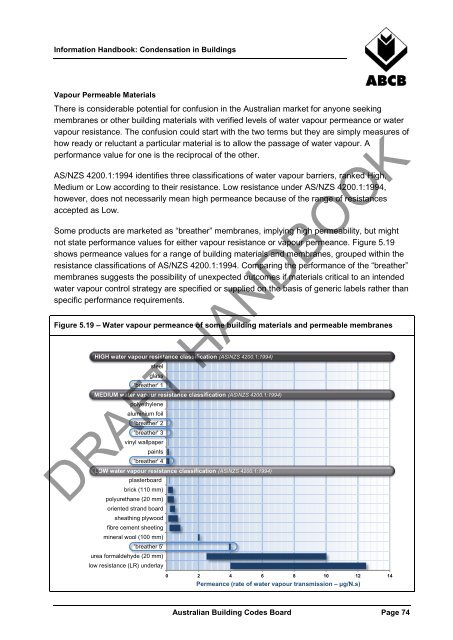Condensation in Buildings - Australian Building Codes Board
Condensation in Buildings - Australian Building Codes Board
Condensation in Buildings - Australian Building Codes Board
You also want an ePaper? Increase the reach of your titles
YUMPU automatically turns print PDFs into web optimized ePapers that Google loves.
Information Handbook: <strong>Condensation</strong> <strong>in</strong> Build<strong>in</strong>gs<br />
Vapour Permeable Materials<br />
There is considerable potential for confusion <strong>in</strong> the <strong>Australian</strong> market for anyone seek<strong>in</strong>g<br />
membranes or other build<strong>in</strong>g materials with verified levels of water vapour permeance or water<br />
vapour resistance. The confusion could start with the two terms but they are simply measures of<br />
how ready or reluctant a particular material is to allow the passage of water vapour. A<br />
performance value for one is the reciprocal of the other.<br />
AS/NZS 4200.1:1994 identifies three classifications of water vapour barriers, ranked High,<br />
Medium or Low accord<strong>in</strong>g to their resistance. Low resistance under AS/NZS 4200.1:1994,<br />
however, does not necessarily mean high permeance because of the range of resistances<br />
accepted as Low.<br />
Some products are marketed as “breather” membranes, imply<strong>in</strong>g high permeability, but might<br />
not state performance values for either vapour resistance or vapour permeance. Figure 5.19<br />
shows permeance values for a range of build<strong>in</strong>g materials and membranes, grouped with<strong>in</strong> the<br />
resistance classifications of AS/NZS 4200.1:1994. Compar<strong>in</strong>g the performance of the “breather”<br />
membranes suggests the possibility of unexpected outcomes if materials critical to an <strong>in</strong>tended<br />
water vapour control strategy are specified or supplied on the basis of generic labels rather than<br />
specific performance requirements.<br />
Figure 5.19 – Water vapour permeance of some build<strong>in</strong>g materials and permeable membranes<br />
HIGH water vapour resistance classification (AS/NZS 4200.1:1994)<br />
steel<br />
glass<br />
'breather' 1<br />
MEDIUM water vapour resistance classification (AS/NZS 4200.1:1994)<br />
polyethylene<br />
alum<strong>in</strong>ium foil<br />
'breather' 2<br />
'breather' 3<br />
v<strong>in</strong>yl wallpaper<br />
pa<strong>in</strong>ts<br />
'breather' 4<br />
LOW water vapour resistance classification (AS/NZS 4200.1:1994)<br />
plasterboard<br />
brick (110 mm)<br />
polyurethane (20 mm)<br />
oriented strand board<br />
sheath<strong>in</strong>g plywood<br />
fibre cement sheet<strong>in</strong>g<br />
m<strong>in</strong>eral wool (100 mm)<br />
'breather 5'<br />
urea formaldehyde (20 mm)<br />
low resistance (LR) underlay<br />
DRAFT HANDBOOK<br />
0 2 4 6 8 10 12 14<br />
Permeance (rate of water vapour transmission – μg/N.s)<br />
<strong>Australian</strong> Build<strong>in</strong>g <strong>Codes</strong> <strong>Board</strong> Page 74
















